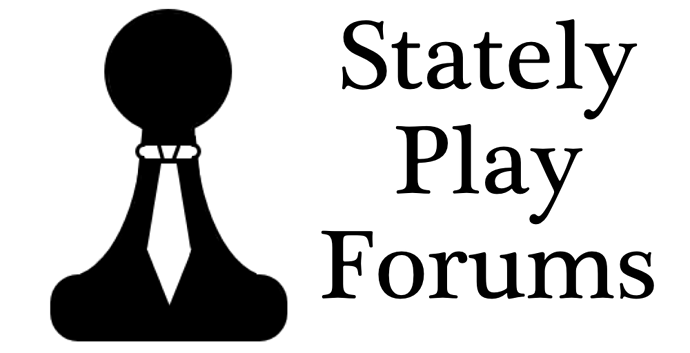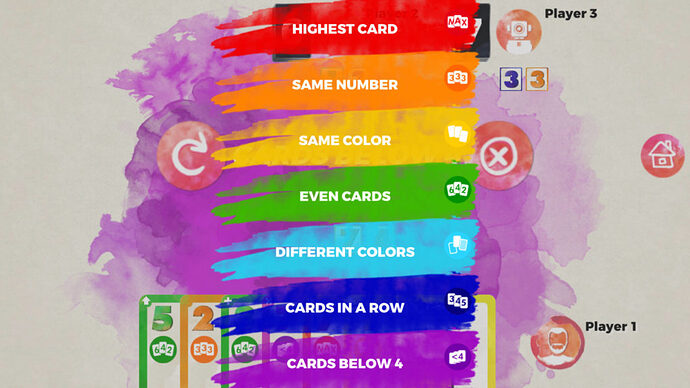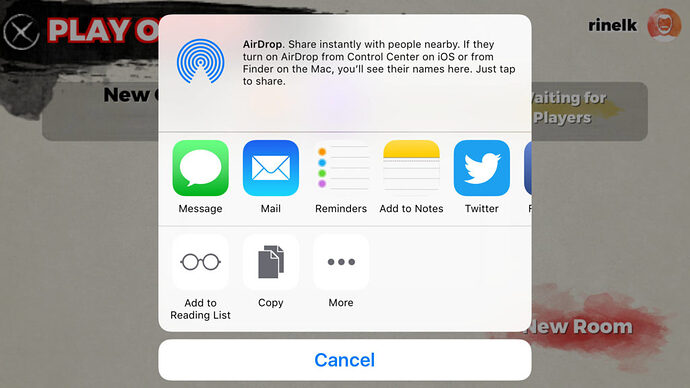Originally published at: http://statelyplay.com/2016/11/04/review-red7/
Red7, a simple but scalable card game now come to iOS, offers a surprisingly strong metaphor for American capitalism and its discontents. Try to think of this claim, not as total BS, but as a helpful mnemonic for the various details the game adds as you activate the three independent optional rule sets. My brain apparently abhors a purely abstract game.
In the basic rules, winning is everything, all the time: if you ever end a turn not in the lead, you lose. Second prize isn’t even a set of steak knives. That’s not so bad, because your hand of cards can be used either to add to your palette (the set of cards with which you meet win conditions) or change the rules. Red’s all about the high card, but if you can’t beat the current high card, maybe you toss a green to lobby for a change so all that matters is how many even cards you have, or an orange so it’s the number of cards with the same digit–whatever puts you ahead. Regulatory capture has its privileges.
[caption id=“attachment_230” align=“aligncenter” width=“1024”]
The rules of the suits. As anyone who’s worked under seven bosses knows, the rules often change without warning.[/caption]On its own, the basic game is mildly interesting, but has a very short planning horizon. Since there are no rules which punish you for having a large palette, you don’t so much want to curate the cards you play as vomit them onto the virtual table at maximum speed. But growing as fast as possible isn’t always the best strategy in business, and Red7 has an Advanced ruleset which allows you to draw a card whenever you change the rules with a card numbered higher than the number of cards in your palette. This makes it much easier to change direction if you maintain a lean, agile stance on the board (which, yes, management types have portmanteaued into “leagile”, because business school apparently causes damage to Broca’s area). It also adds a substantial hand management element to the game, as you try to stay in the game without playing too many cards so you can toss cards you expect to be less useful in favor of a chance at something which will improve your ability to outlast your opponents.
The second optional set of rules adds points: you play several hands until someone reaches the target score (which scales inversely with the number of players, which contains the duration somewhat). What’s so neat about this option is that you score points based on the total value of the cards in your palette which contributed to your win. So if you have a 4-5-6-7 straight under the indigo rule, you score 22 points (which gets you over halfway to winning by itself), but if you win with a 1 under the violet rule, you get a single point. Much of challenge of this mode consists in evaluating the strength of your hand in the context of what others seem to be playing, and ending losing hands as early as possible while dragging out winning ones. In combination with the Advanced rules, this means the previously attractive strategy of delaying to draw more cards has a potential cost–you gain information, but might increase your opponent’s margin of victory. Sometimes a move which improves your fundamentals is still a bad move if it helps your competition more.
[caption id=“attachment_231” align=“aligncenter” width=“1024”]
You very rarely lose outright in Red7. Instead, you end up in a position from which you can’t win, and your only way forward is to resign.[/caption]Finally, the game has a set of rules in which different actions trigger when odd cards are played. 7 is still a big number, but balances that by making you discard a card already in your palette (possibly to change the rule). 5 makes you play another card, which is helpful for avoiding elimination in the short term, but costs you the flexibility afforded by cards in hand. 3s make you draw a new card, which means they’re a wonderful investment if you’re doing well enough that you can afford them. And 1s are everything that’s wrong with Communism; they let you choose anyone who’s not doing worse than you and eliminate one of their cards. It’s the resentment of success which so threatens the ethos of valuing productive labor. None of these abilities are complicated, but they combine to balance some of the luck of the draw (though I do wonder whether 3s are now overpowered) and give players enough more to consider that even a seasoned tactician will find the decision tree a challenge to explore.
So, here’s a game which is simple to learn, deep enough to satisfy, presented with lovely and approachable art, and scales to suit a variety of players and durations. Unfortunately, it’s also the first game with such high potential for multiplayer which I’ve played since the release of iOS 10, with its (sort of) retirement of Game Center. I was initially flabbergasted when I got what looked like a bizarre bug to me–I tapped “Challenge” in the main menu and, when I tried to invite someone to an asynchronous game, the share screen popped up. That’s not a bug. Game invitations are basically just hypertext links which you can transmit any way you want. You can airdrop to a local device, send an iMessage, email the link, post it on a forum somewhere, or share to social media. I have high hopes for a system like this for a forum-based tournament, because you don’t have to be Game Center friends with someone to invite them to a game. But what it doesn’t seem to allow is matchmaking of any kind. Feel like a game but don’t know anyone who owns it? Well, it’s a good thing the AI is decent. I can usually handle the easy AI, and the medium is fair, but the hard AI makes me feel like I’ll never know the love of a real woman. It also thinks long enough for me to become impatient with the computer’s analysis paralysis, but it wouldn’t be such a compelling game if there weren’t a large possibility space to search.
[caption id=“attachment_232” align=“aligncenter” width=“1024”]
Took me a while to figure out why I was seeing this when I wanted to play a game.[/caption]Though there are reports of numerous bugs, I’ve only had one crash out of the app. Online games seem not to update unless you exit them and return to them, but that may be an unfortunate design choice rather than an actual bug. I also wish the interface designers paid a little more attention to making the relevant options big–they’re usually fine, and the game has a robust undo feature, but any mistap when you’re aiming at a tiny target surrounded by tons of white space rankles.
Red7 in cardboard form was justifiably nominated for a bunch of awards when it released in 2014. It not only does a lot with simple rules, it offers a lot of different options, which means most players will be able to find at least one combination which gives them features they appreciate in a game. It plays well on both iPad and plus-sized iPhone screens, and I suspect it would be fine all the way down to the smallest screens that can run it. If you’re bothered by buggy early releases, value an option to play random humans, or just don’t have much interest in an abstract with no progression, you’re best served by holding off on or skipping this one. If you’re willing to tolerate those facts, Red7 is approachable enough to satisfy the impulse we often have to play something simple, but there’s always something new to think about if you’re interested.



